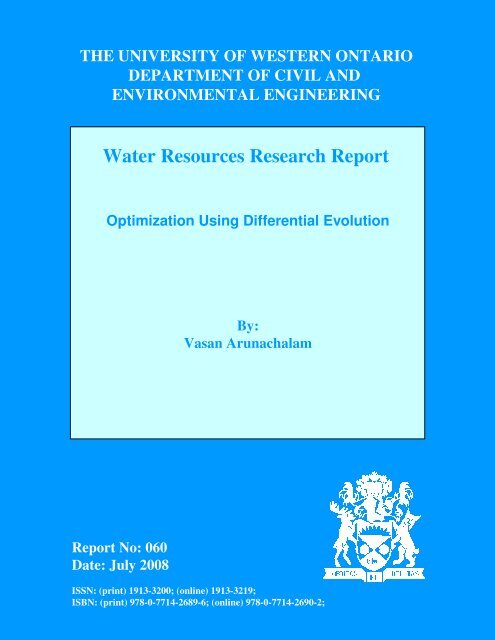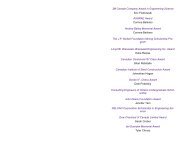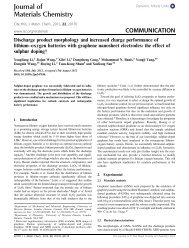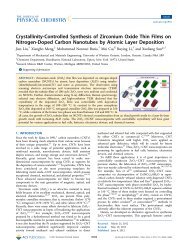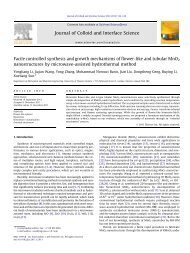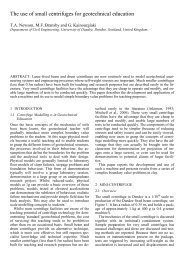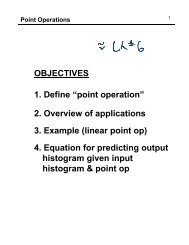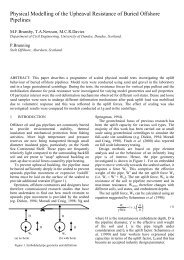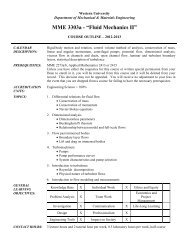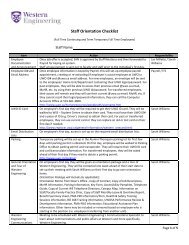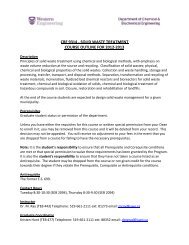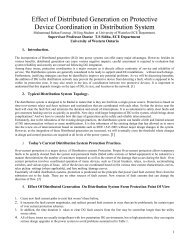Water Resources Research Report - Western Engineering ...
Water Resources Research Report - Western Engineering ...
Water Resources Research Report - Western Engineering ...
Create successful ePaper yourself
Turn your PDF publications into a flip-book with our unique Google optimized e-Paper software.
THE UNIVERSITY OF WESTERN ONTARIO<br />
DEPARTMENT OF CIVIL AND<br />
ENVIRONMENTAL ENGINEERING<br />
<strong>Water</strong> <strong>Resources</strong> <strong>Research</strong> <strong>Report</strong><br />
Optimization Using Differential Evolution<br />
<strong>Report</strong> No: 060<br />
Date: July 2008<br />
By:<br />
Vasan Arunachalam<br />
ISSN: (print) 1913-3200; (online) 1913-3219;<br />
ISBN: (print) 978-0-7714-2689-6; (online) 978-0-7714-2690-2;
OPTIMIZATION USING DIFFERENTIAL EVOLUTION<br />
By<br />
VASAN ARUNACHALAM<br />
Facility for Intelligent Decision Support<br />
Department of Civil and Environmental <strong>Engineering</strong><br />
The University Of <strong>Western</strong> Ontario, London, Ontario, Canada<br />
JULY 2008
ABSTRACT<br />
The book explains in detail the working of Differential Evolution optimization algorithm.<br />
It also provides documentation for the use of Differential Evolution computer program to<br />
solve user-defined optimization problems. The computer program is written in C<br />
language for Windows environment. The book also demonstrates how to modify the<br />
program using an example optimization problem.<br />
This source code is distributed for academic purposes only. It has no warranty implied or<br />
given, and the author assumes no liability for damage resulting from its use or misuse.<br />
The author can be contacted for any comments by email at<br />
vasan.arunachalam@gmail.com.<br />
i
TABLE OF CONTENTS<br />
ABSTRACT……………………………………………………………………... i<br />
TABLE OF CONTENTS………………………………………………………... ii<br />
1 INTRODUCTION……………………………………………………………… 1<br />
2 DIFFERENTIAL EVOLUTION……………………………………………… 3<br />
WORKING OF THE DE ALGORITHM……………………………………….. 3<br />
AN ILLUSTRATIVE EXAMPLE………..…………………………………….. 7<br />
3 HOW TO RUN THE DE PROGRAM?............................................................. 10<br />
4 CONCLUSION…………………………………………………………………. 19<br />
REFERENCES…………………………………………………………………. 20<br />
APPENDIX A - SOURCE CODE OF THE DE ALGORITHM IN C……… 21<br />
APPENDIX B - PREVIOUS REPORTS IN THE SERIES 35<br />
ii
CHAPTER<br />
1<br />
INTRODUCTION<br />
Optimization is a procedure through which the best possible values of decision variables<br />
are obtained under the given set of constraints and in accordance to a selected<br />
optimization objective function. The most common optimization procedure applies to a<br />
design that will minimize the total cost or maximize the possible reliability or any other<br />
specific objective. Fields of science and engineering, business decision-making and<br />
industry are all rich in problems that require the implementation of optimization<br />
approach. Since, most real world optimization problems seem to be both fundamentally<br />
and practically hard, research into better algorithms remains valuable and continues, so<br />
that, one can guarantee to find the best solution using an efficient optimization algorithm.<br />
Nowadays, there exist a lot of optimization algorithms that work using gradient-based<br />
and heuristic-based search techniques in deterministic and stochastic contexts. In order to<br />
widen the applicability of the optimization approach to various problem domains, natural<br />
and physical principles are mimicked to develop robust optimization algorithms.<br />
Evolutionary algorithms, simulated annealing, ant colony optimization, memetic<br />
algorithms, particle swarm optimization are few examples of such algorithms.<br />
Over the last decade, evolutionary algorithms have been extensively used in various<br />
problem domains and succeeded in effectively finding the near optimal solutions. The<br />
present book provides a detailed description of one such evolutionary algorithm, named,<br />
Differential Evolution (DE). Since its inception in 1995, DE has earned a reputation of a<br />
very effective global optimizer (Storn and Price, 1995). Chapter 1 begins with an<br />
introduction to the optimization and Chapter 2 introduces the detailed working of DE<br />
1
algorithm with an illustrative example. Chapter 3 provides the instructions for using the<br />
DE computer program developed for Windows environment that accompanies this book<br />
on CD-ROM. Chapter 4 concludes with few practical suggestions for the users of the DE<br />
computer program. An Appendix to the text contains description of the source code of<br />
DE software developed in C programming language.<br />
2
WORKING OF THE DE ALGORITHM<br />
CHAPTER<br />
2<br />
DIFFERENTIAL EVOLUTION<br />
Differential Evolution (DE) algorithm is a branch of evolutionary programming<br />
developed by Rainer Storn and Kenneth Price (Price and Storn, 1997) for optimization<br />
problems over continuous domains. In DE, each variable’s value is represented by a real<br />
number. The advantages of DE are its simple structure, ease of use, speed and robustness.<br />
DE is one of the best genetic type algorithms for solving problems with the real valued<br />
variables. Differential Evolution is a design tool of great utility that is immediately<br />
accessible for practical applications. DE has been used in several science and engineering<br />
applications to discover effective solutions to nearly intractable problems without<br />
appealing to expert knowledge or complex design algorithms. If a system is amenable to<br />
being rationally evaluated, DE can provide the means for extracting the best possible<br />
performance from it. Differential Evolution uses mutation as a search mechanism and<br />
selection to direct the search toward the prospective regions in the feasible region.<br />
Genetic Algorithms generate a sequence of populations by using selection mechanisms.<br />
Genetic Algorithms use crossover and mutation as search mechanisms. The principal<br />
difference between Genetic Algorithms and Differential Evolution is that Genetic<br />
Algorithms rely on crossover, a mechanism of probabilistic and useful exchange of<br />
information among solutions to locate better solutions, while evolutionary strategies use<br />
mutation as the primary search mechanism.<br />
DE is a population based search technique which utilizes NP variables as population of D<br />
dimensional parameter vectors for each generation. The initial population is chosen<br />
3
andomly if no information is available about the problem. In the case of the available<br />
preliminary solution, the initial population is often generated by adding normally<br />
distributed random deviations to the preliminary solution. The basic idea behind DE is a<br />
new scheme for generating trial parameter vectors. DE generates new parameter vectors<br />
by adding the weighted difference vector between two population members to a third<br />
member. If the resulting vector yields a lower objective function value than a<br />
predetermined population member, the newly generated vector replaces the vector with<br />
which it was compared. In addition, the best parameter vector is evaluated for every<br />
generation in order to keep track of the progress that is made during the optimization<br />
process. Extracting the distance and the direction information from the population to<br />
generate random deviations result in an adaptive scheme with excellent convergence<br />
properties (Price et al., 2005).<br />
DE maintains two arrays, each of which holds a population size NP and D dimensional,<br />
real-valued vectors. The primary array holds the current vector population, while the<br />
secondary array accumulates vectors that are selected for the next generation. In each<br />
generation, NP competitions are held to determine the composition of the next<br />
generation.<br />
Every pair of vectors ( a , b ) X X defines a vector differential: ) ( a b X X − . When X a and<br />
X b are chosen randomly, their weighted differential is used to perturb another randomly<br />
chosen vector X c . This process can be mathematically expressed as:<br />
′<br />
X c = X c + F(<br />
X a − X b )<br />
The weighting, or scaling, factor F is a user supplied constant in the optimal range<br />
between 0.5 and 1.0 (DE, 2008). In every generation, each primary array vector X i is<br />
targeted for crossover with a vector like<br />
(1)<br />
′<br />
X c to produce a trial vector X t . Thus, the trial<br />
vector is the child of two parents, a noisy random vector and the target vector against<br />
which it must compete. Uniform crossover (that can take child vector parameters from<br />
4
one parent more often than it does from others) is used with a crossover constant (CR), in<br />
the optimal range of 0.5 to 1.0 (DE, 2008) which actually represents the probability that<br />
the child vector inherits the parameter values from the noisy random vector. When CR =<br />
1, for example, every trial vector parameter is certain to come from ′<br />
X c . On the other<br />
hand, if CR = 0, all but one trial vector parameter comes from the target vector. To ensure<br />
that X t differs from X i by at least one parameter, the final trial vector parameter always<br />
comes from the noisy random vector even when CR = 0. Then the objective function<br />
corresponding to the trial vector is compared with that of the target vector, and the vector<br />
that has the lower objective function value (for minimization) of the two would survive<br />
for the next generation. This process is continued until the termination criterion of a<br />
preset maximum number of generations (MAXGEN) is met, and difference in objective<br />
function values between two consecutive generations reaches a small value. Figure 1<br />
shows the working of the DE algorithm.<br />
Fig. 1. Working of Differential Evolution Algorithm<br />
5
Price & Storn (1997) gave the working principle of DE with single strategy. Later on,<br />
they suggested ten different strategies for DE. Different strategies can be adopted in the<br />
DE algorithm depending upon the type of problem to which DE is applied. The strategies<br />
can vary based on the vector to be perturbed, number of difference vectors considered for<br />
perturbation, and finally the type of crossover used. The following are the ten different<br />
working strategies:<br />
1. DE/best/1/exp<br />
2. DE/rand/1/exp<br />
3. DE/rand-to-best/1/exp<br />
4. DE/best/2/exp<br />
5. DE/rand/2/exp<br />
6. DE/best/1/bin<br />
7. DE/rand/1/bin<br />
8. DE/rand-to-best/1/bin<br />
9. DE/best/2/bin<br />
10. DE/rand/2/bin<br />
The general convention used above is DE/x/y/z. DE stands for Differential Evolution, x<br />
represents a string denoting the vector to be perturbed, y is the number of difference<br />
vectors considered for perturbation of x, and z stands for the type of crossover being used<br />
(exp: exponential; bin: binomial). Hence the perturbation can be either in the best vector<br />
of the previous generation or in any randomly chosen vector. Similarly for perturbation<br />
either single or two vector differences can be used. For perturbation with a single vector<br />
difference, out of the three distinct randomly chosen vectors, the weighted vector<br />
differential of any two vectors is added to the third one. Similarly for perturbation with<br />
two vector differences, five distinct vectors, other than the target vector are chosen<br />
randomly from the current population. Out of these, the weighted vector difference of<br />
each pair of any four vectors is added to the fifth one for perturbation. In exponential<br />
crossover, the crossover is performed on the D variables in one loop until it is within the<br />
CR bound. The first time a randomly picked number between 0 and 1 goes beyond the<br />
CR value, no crossover is performed and the remaining D variables are left intact. In<br />
6
inomial crossover, the crossover is performed on each of the D variables whenever a<br />
randomly picked number between 0 and 1 is within the CR value. So for high values of<br />
CR, the exponential and binomial crossover methods yield similar results.<br />
A strategy that works out to be the best for a given problem may not work well when<br />
applied to a different problem. Also, the strategy and the key parameters to be adopted<br />
for a problem are to be determined by trial and error. However, strategy-7<br />
(DE/rand/1/bin) appears to be the most successful and the most widely used strategy. In<br />
all, three factors control evolution under DE, the population size NP, the weight applied<br />
to the random differential F and the crossover constant CR. More details regarding DE<br />
are available in Price and Storn (1997), Onwubolu and Babu (2004) and Price and Storn<br />
(2005).<br />
AN ILLUSTRATIVE EXAMPLE<br />
A simple numerical example is presented to illustrate the DE algorithm. Let us consider<br />
the following objective function:<br />
Minimize f ( x)<br />
= x + x + x<br />
(2)<br />
1<br />
2<br />
3<br />
The initial population is generated (chosen randomly between the bounds of decision<br />
variables, in this case within 0 and 1, for the three decision variables. The population<br />
along with its respective objective function values is shown in Table 1. The first member<br />
of the population “Individual 1” is set as the target vector.<br />
In order to generate the noisy random vector, three individuals (Individual 2, Individual 4<br />
and Individual 6) from the population size are selected randomly (ignoring “Individual<br />
1”, since it is set as the target vector). The weighted difference between “Individual 2”<br />
and “Individual 4” is added to the third randomly chosen vector “Individual 6” to<br />
generate the noisy random vector. The weighting factor F is chosen as 0.80 and the<br />
weighted difference vector is obtained in Table 2 and the noisy random vector in Table 3.<br />
7
Individual<br />
1<br />
Table 1. An illustrative example<br />
Population Size NP = 6 (user defined), D = 3<br />
Individual<br />
2<br />
Individual<br />
3<br />
Individual<br />
4<br />
Individual<br />
5<br />
Individual<br />
6<br />
x 1 0.68 0.92 0.22 0.12 0.40 0.94<br />
x 2 0.89 0.92 0.14 0.09 0.81 0.63<br />
x 3 0.04 0.33 0.40 0.05 0.83 0.13<br />
f (x)<br />
1.61 2.17 0.76 0.26 2.04 1.70<br />
Table 2. Calculation of the weighted difference vector for the illustrative example<br />
Individual<br />
2<br />
Individual<br />
4<br />
Difference<br />
Vector<br />
Weighted<br />
Difference<br />
Vector<br />
x 1 0.92 0.12 = 0.80 = 0.64<br />
x 2 0.92 - 0.09 = 0.83<br />
× F<br />
(F = 0.80)<br />
= 0.66<br />
0.05 = 0.28<br />
= 0.22<br />
x 3 0.33<br />
Table 3. Calculation of the noisy random vector for the illustrative example<br />
Weighted<br />
Difference<br />
Vector<br />
Individual<br />
6<br />
Noisy<br />
Random<br />
Vector<br />
x 1 0.64 0.94 = 1.58<br />
x 0.66 + 0.63 = 1.29<br />
2<br />
x 3 0.22<br />
0.13 = 0.35<br />
The noisy random vector does a crossover with the target vector to generate the trial<br />
vector as shown in Table 4. This is carried out by (1) generating random numbers equal<br />
to the dimension of the problem (2) for each of the dimensions: if random number > CR;<br />
copy the value from the target vector, else copy the value from the noisy random vector<br />
into the trial vector. In this example, the crossover constant CR is chosen as 0.50.<br />
8
Table 4. Generation of the trial vector for the illustrative example<br />
Target<br />
Vector<br />
Noisy<br />
Random<br />
Vector<br />
Trial<br />
Vector<br />
x 1 0.68<br />
Crossover<br />
1.58 = 1.58<br />
x 2 0.89 (CR =<br />
0.50)<br />
1.29<br />
0.35<br />
= 0.89<br />
= 0.04<br />
x 3 0.04<br />
f (x)<br />
1.61 3.22 2.51<br />
The objective function of the trial vector is compared with that of the target vector and<br />
the vector with the lowest value of the two becomes “Individual 1” for the next<br />
generation. To evolve “Individual 2” for the next generation, the second member of the<br />
population is set as target vector and the above process is repeated. This process is<br />
repeated NP times till the new population set array is filled which completes one<br />
generation. Once the termination criterion is met, the algorithm ends.<br />
Table 5. New population for next generation for the illustrative example<br />
Individual<br />
1<br />
x 1 0.68<br />
x 2 0.89<br />
x 3 0.04<br />
f (x)<br />
1.61<br />
Individual<br />
2<br />
New Population for Next Generation<br />
Individual<br />
3<br />
Individual<br />
4<br />
Individual<br />
5<br />
Individual<br />
6<br />
9
CHAPTER<br />
3<br />
HOW TO RUN THE DE PROGRAM?<br />
Single objective Differential Evolution optimization algorithm has been programmed in<br />
C language using Microsoft Visual C++ 6.0 for Windows. This Chapter explains how to<br />
use the DE computer program for solving any optimization problem. The source code of<br />
the DE program is available in Appendix I. The CD enclosed along with this book<br />
contains a folder named “Program”. The folder contains the C program file “DE.c” which<br />
requires two input files, “Limits.txt” and “ParameterLimits.txt”. The program generates<br />
two output files, “<strong>Report</strong>DE.html” and “Convergence.txt”.<br />
In order to learn how to use the DE program, consider the following optimization<br />
problem:<br />
subject to<br />
( ) ( ) 2<br />
2<br />
2<br />
2<br />
x + x −11<br />
+ x + x 7<br />
Minimize f ( x)<br />
=<br />
−<br />
( x − 5)<br />
4x<br />
x , x<br />
1<br />
1<br />
1<br />
− x<br />
2<br />
2<br />
2<br />
≥ 0<br />
+ x<br />
2<br />
2<br />
− 20 ≤ 0<br />
1<br />
− 26 ≤ 0<br />
2<br />
The algorithm is designed to accept optimization problem with an objective of<br />
minimization type. If the objective of the problem is of maximization type, it should be<br />
modified accordingly to use in the program. Each decision variable is represented from<br />
x[0], x[1], x[2] and so on. Accordingly, the objective function for the example is written<br />
as follows:<br />
1<br />
(x[0]*x[0]+x[1]-11)*(x[0]*x[0]+x[1]-11)+(x[0]+x[1]*x[1]-7)*(x[0]+x[1]*x[1]-7)<br />
2<br />
10
To enter the constraints, the inequality constraints should be modified to the less or equal<br />
format, g( x)<br />
≤ 0.<br />
If the problem is an unconstrained optimization problem, the user need<br />
not enter anything in the space specified for the constraints coding. The constraints of the<br />
example are entered as follows:<br />
/* Constraint 1*/<br />
temp = (x[0]-5)*(x[0]-5) + x[1]*x[1] - 26;<br />
val[1] = max(temp,0);<br />
/* Constraint 2 */<br />
temp = 4*x[0] + x[1] -20;<br />
val[2] = max(temp,0);<br />
If the first constraint of the example is an equality constraint, the constraint should be<br />
entered as follows:<br />
/* Constraint 1 (Equality Condition) */<br />
val[1] = abs((x[0]-5)*(x[0]-5) + x[1]*x[1] – 26);<br />
where val[1] and val[2] represent the amount of violation for each constraint. These<br />
values are multiplied by a penalty co-efficient penal[1] and penal[2] (entered by the user<br />
of the program), which is then added to the objective function to continue the process of<br />
optimization. This process is often termed as penalty function approach. A simple<br />
additive penalty function approach is used in order to convert the constrained problem<br />
into unconstrained problem. Due to this conversion, the solution falling outside the<br />
feasible region is penalized and forced to fall into the feasible solution space after a few<br />
generations. However, the penalty function method has certain weaknesses that are fatal<br />
when the penalty parameters are large. Penalty functions tend to be ill conditioned near<br />
the boundary of the feasible domain and that may result in a local optimal solution or an<br />
11
infeasible solution. Careful selection of the penalty parameters is required for the proper<br />
convergence to a feasible optimal solution.<br />
The main C program has many user-defined functions. The user needs to enter objective<br />
function and constraints in the user-defined function evaluate( ). The program code is<br />
commented, so the user needs to follow the comments to enter the number of constraints,<br />
ncons (in this example, ncons = 2), objective function, constraints (if any) and the penalty<br />
coefficient for each constraint (if any), at the appropriate places. The “evaluate( )”<br />
function for the example problem is displayed below:<br />
double evaluate(double *x)<br />
{<br />
int ncons, i;<br />
double *val, *penal, temp;<br />
long double value=0;<br />
feval++;<br />
/* DO NOT CHANGE ANYTHING ABOVE */<br />
/* Enter the Number of Constraints to the variable ncons*/<br />
ncons = 2;<br />
/*------------------------------------------------------*/<br />
val = (double *)malloc(sizeof(double)*ncons);<br />
penal = (double *)malloc(sizeof(double)*ncons);<br />
penal[0]=1;<br />
/*----------------------CODE YOUR OBJECTIVE FUNCTIONS HERE------------*/<br />
/*All functions must be of minimization type*/<br />
/*============Start Coding Your Objective Function=============*/<br />
val[0] = (x[0]*x[0]+x[1]-11)*(x[0]*x[0]+x[1]-11) +<br />
(x[0]+x[1]*x[1]-7)*(x[0]+x[1]*x[1]-7);<br />
/*========END YOUR CODING UPTO THIS POINT============*/<br />
12
}<br />
/*----------------------CODE YOUR CONSTRAINTS HERE------------*/<br />
/*All functions must be of minimization type, negate maximization functions */<br />
/*Constraints must be of the following type: g(x)
}<br />
/*--------------------CODE YOUR OBJECTIVE FUNCTIONS HERE------------*/<br />
/*All functions must be of minimization type*/<br />
/*============Start Coding Your Objective Function=============*/<br />
value = (x[0]*x[0]+x[1]-11)*(x[0]*x[0]+x[1]-11) +<br />
(x[0]+x[1]*x[1]-7)*(x[0]+x[1]*x[1]-7);<br />
/*=========END CODING UPTO THIS POINT===================*/<br />
return value;<br />
After inserting the objective function and constraints, the user needs to prepare the two<br />
input files (“Limits.txt” and “ParameterLimits.txt”). In the “Limits.txt” input file, the<br />
lower and upper bound for each decision variable separated by a tab, is entered. The<br />
number of decision variables for the example is two. The lower and upper bounds for<br />
each variable is assumed as 0 and 10 respectively. The “Limits.txt” input file for the<br />
example is as follows:<br />
0 10 � Lower and Upper bound of first decision variable<br />
0 10 � Lower and Upper bound of second decision variable<br />
The “ParameterLimits.txt” input file requires the number of decision variables (in the<br />
first row), maximum number of generations (in the second row), minimum and maximum<br />
number of population (NP), crossover constant (CR), weighting factor (F) along with<br />
their step length for sensitivity analysis in the third, fourth and fifth rows respectively.<br />
The input file for the example problem is as follows:<br />
2 � Number of decision variables<br />
30 � Maximum number of generations<br />
20 20 10 � Minimum, maximum and step length for NP<br />
0.8 0.9 0.1 � Minimum, maximum and step length for CR<br />
0.5 0.6 0.1 � Minimum, maximum and step length for F<br />
14
This completes the preparation of inputs files. To generate the optimal set of solutions for<br />
the optimization problem, DE program is compiled and executed. The program can be<br />
compiled and execution using any standard C compiler for Windows environment. After<br />
the execution starts, a DOS window pops up (as shown in Figure 2), displaying the<br />
progress of the optimization process.<br />
Fig. 2. DOS window displaying the progress of optimization<br />
When the program is run for different combinations of NP, CR and F, the optimal set of<br />
parameters is determined based on two factors i.e., minimum objective function value<br />
and lower CPU time requirement. In any given situation, if minimum objective function<br />
values are the same for any given combination(s), the next criteria that is chosen for<br />
selecting optimal combination is lower CPU time requirement. In this program, these two<br />
factors are considered for choosing optimal set of parameters. Two output files<br />
(“<strong>Report</strong>DE.html” and “Convergence.txt”) are generated after the successful completion<br />
of the program’s execution.<br />
“<strong>Report</strong>DE.html” output file prints the detailed record of the objective function value for<br />
all combinations of NP, CR and F for all ten strategies. It also records the best ever<br />
combination for each strategy along with its objective function value, constraint<br />
15
violation, number of function evaluations and computational time. The optimal value of<br />
objective function and decision variables for the optimization problem is also recorded.<br />
The output file for the example is as follows:<br />
Optimization by Differential Evolution<br />
Strategy 1 :<br />
NP = 20<br />
NP = 20 F = 0.50 F = 0.60<br />
CR = 0.80 1.776225E-005 (31 ms) 8.532469E-005 (62 ms)<br />
CR = 0.90 1.954033E-006 (63 ms) 1.214437E-004 (78 ms)<br />
Strategy 2 :<br />
NP = 20<br />
NP = 20 F = 0.50 F = 0.60<br />
CR = 0.80 8.589940E-010 (78 ms) 7.677683E-009 (78 ms)<br />
CR = 0.90 3.381982E-008 (94 ms) 7.682233E-007 (94 ms)<br />
Strategy 3 :<br />
NP = 20<br />
NP = 20 F = 0.50 F = 0.60<br />
CR = 0.80 3.777920E-005 (78 ms) 3.098915E-005 (94 ms)<br />
CR = 0.90 4.402272E-007 (93 ms) 1.464849E-004 (94 ms)<br />
Strategy 4 :<br />
NP = 20<br />
NP = 20 F = 0.50 F = 0.60<br />
CR = 0.80 2.198994E-004 (78 ms) 5.341329E-007 (110 ms)<br />
CR = 0.90 7.713227E-006 (109 ms) 1.041404E-004 (78 ms)<br />
Strategy 5 :<br />
NP = 20<br />
NP = 20 F = 0.50 F = 0.60<br />
CR = 0.80 5.074285E-007 (94 ms) 4.970142E-007 (94 ms)<br />
CR = 0.90 5.250883E-005 (93 ms) 1.778123E-007 (94 ms)<br />
Strategy 6 :<br />
NP = 20<br />
NP = 20 F = 0.50 F = 0.60<br />
CR = 0.80 2.001744E-007 (110 ms) 6.724820E-005 (93 ms)<br />
CR = 0.90 8.234626E-008 (125 ms) 3.239539E-005 (94 ms)<br />
Strategy 7 :<br />
NP = 20<br />
NP = 20 F = 0.50 F = 0.60<br />
CR = 0.80 7.588175E-009 (94 ms) 9.897662E-008 (94 ms)<br />
CR = 0.90 7.055386E-009 (93 ms) 2.659110E-007 (94 ms)<br />
Strategy 8 :<br />
NP = 20<br />
NP = 20 F = 0.50 F = 0.60<br />
CR = 0.80 1.362700E-006 (109 ms) 1.225594E-005 (110 ms)<br />
CR = 0.90 4.150216E-008 (109 ms) 7.398449E-006 (94 ms)<br />
Strategy 9 :<br />
NP = 20<br />
NP = 20 F = 0.50 F = 0.60<br />
CR = 0.80 5.604798E-006 (109 ms) 4.277174E-004 (94 ms)<br />
CR = 0.90 3.914301E-005 (109 ms) 3.000180E-004 (94 ms)<br />
16
Strategy 10 :<br />
NP = 20<br />
NP = 20 F = 0.50 F = 0.60<br />
CR = 0.80 1.259527E-009 (110 ms) 8.828525E-009 (93 ms)<br />
CR = 0.90 1.220839E-006 (94 ms) 3.677681E-007 (94 ms)<br />
Results :<br />
Strategy<br />
No.<br />
Strategy NP CR F Optimal Value Constraint<br />
Violation<br />
NFE<br />
Time<br />
Taken(ms)<br />
1 DE/rand/1/bin 20 0.90 0.50<br />
1.954033E-<br />
006<br />
0.0000E+000 703 63<br />
2 DE/best/1/bin 20 0.80 0.50<br />
8.589940E-<br />
010<br />
0.0000E+000 681 78<br />
3 DE/best/2/bin 20 0.90 0.50<br />
4.402272E-<br />
007<br />
0.0000E+000 681 93<br />
4 DE/rand/2/bin 20 0.80 0.60<br />
5.341329E-<br />
007<br />
0.0000E+000 769 110<br />
5<br />
DE/rand-tobest/1/bin<br />
20 0.90 0.60<br />
1.778123E-<br />
007<br />
0.0000E+000 681 94<br />
6 DE/rand/1/exp 20 0.90 0.50<br />
8.234626E-<br />
008<br />
0.0000E+000 879 125<br />
7 DE/best/1/exp 20 0.90 0.50<br />
7.055386E-<br />
009<br />
0.0000E+000 681 93<br />
8 DE/best/2/exp 20 0.90 0.50<br />
4.150216E-<br />
008<br />
0.0000E+000 725 109<br />
9 DE/rand/2/exp 20 0.80 0.50<br />
1.954033E-<br />
006<br />
0.0000E+000 747 109<br />
10<br />
DE/rand-tobest/1/exp<br />
20 0.80 0.50<br />
1.259527E-<br />
009<br />
0.0000E+000 769 110<br />
Best Strategy is Strategy DE/rand/1/bin<br />
Minimum constraint violation (CV) : 0.0000E+000<br />
Minimum objective value with min CV: 1.954033E-006<br />
Minimum time taken : 63<br />
Parameter Value<br />
X1<br />
3.000126<br />
2.000219<br />
End of report<br />
X2<br />
“Convergence.txt” output file prints the record of the best objective function value for<br />
each generation, strategy wise.<br />
The maximum number of generations for the program has been limited to 5000. If the<br />
user requires to run the program for more than 5000 generations, a minor modification in<br />
the program is necessary. The first line in the main( ) program assigns the variable<br />
nx=5000. The value of the variable nx needs to be modified accordingly. Similarly, the<br />
value of EPSILON (i.e., the difference in objective function values between two<br />
consecutive generations) can also be changed by the user in the program. It can be found<br />
in the 17 th line of the program as “#define EPSILON 0.000001”. The default value of<br />
17
EPSILON is set as 0.000001 which is good enough for all kinds of optimization<br />
problems.<br />
Thus, one can modify the program to determine the optimal solution for any optimization<br />
problem. This source code is distributed for academic purposes only. It has no warranty<br />
implied or given, and the author assumes no liability for damage resulting from its use or<br />
misuse. Please forward comments or question to the author at<br />
vasan.arunachalam@gmail.com.<br />
18
CHAPTER<br />
4<br />
CONCLUSION<br />
The book explains optimization using the Differential Evolution (DE) algorithm in detail.<br />
The DE computer program is available on the accompanying CD. The source code is<br />
written in C language in Microsoft Visual C++ 6.0 environment and a basic knowledge of<br />
C programming language is sufficient to modify the program. The explanations on how<br />
to modify the DE code to use it for various optimization problems are provided. The use<br />
of the DE computer program is illustrated using an example problem.<br />
19
REFERENCES<br />
DE. “Differential Evolution Homepage.” <br />
(Last accessed on July 15, 2008).<br />
Onwubolu, G. C., and Babu, B. V. (2004). New Optimization Techniques in <strong>Engineering</strong>,<br />
Springer-Verlag, Germany.<br />
Price, V. Kenneth., and Storn, M. Rainer. (1997). “Differential evolution - A simple<br />
evolution strategy for fast optimization.” Dr. Dobb's Journal, 22, 18-24 and 78.<br />
Price, V. Kenneth., Storn, M. Rainer., and Lampinen, A. Jouni. (2005). Differential<br />
evolution: A practical approach to global optimization. Springer-Verlag Berlin,<br />
Heidelberg.<br />
Storn, R., Price, V. Kenneth. (1995). Differential Evolution – A simple and eifficient<br />
adaptive scheme for global optimization over continous spaces. Technical <strong>Report</strong> TR-95-<br />
012, ICSI.<br />
20
APPENDIX A<br />
SOURCE CODE OF DE ALGORITHM IN C<br />
#include <br />
#include <br />
#include <br />
#include <br />
#include <br />
double sumarray(double *x,int start,int end);<br />
double evaluateWOpenalty(double *x);<br />
double evaluate(double *x);<br />
double getDouble(const char *prompt);<br />
double rnd_uni();<br />
int getInt(const char *prompt);<br />
void copyPoint(double *dest,double *source,int D);<br />
double optimise(int gen_max, int D, int NP,double F,double CR,int strategy,double *Point);<br />
int feval;<br />
long timeTaken;<br />
double **x1, **x2, resultpen;<br />
#define EPSILON 0.000001<br />
#define startBold fprintf(fp,"\n");fprintf(fp,"")<br />
#define endBold fprintf(fp,"\n");fprintf(fp,"")<br />
#define doubleLine fprintf(fp,"\n")<br />
#define singleLine fprintf(fp,"\n")<br />
#define Heading1 fprintf(fp,"\n")<br />
#define endHeading1 fprintf(fp,"\n")<br />
#define Heading2 fprintf(fp,"\n")<br />
#define endHeading2 fprintf(fp,"\n")<br />
/* HTML <strong>Report</strong> Generation functions */<br />
void startHTMLBODY(FILE *fp)<br />
{<br />
fprintf(fp,"");<br />
fprintf(fp,"
order-bottom: 1px solid #cccccc;\<br />
border-left: 1px none #e9e9e9;\<br />
}\<br />
.data {\<br />
font-family: Arial, Helvetica, sans-serif;\<br />
font-size: 11px;\<br />
vertical-align: middle;\<br />
border-top-width: 1px;\<br />
border-right-width: 1px;\<br />
border-bottom-width: 1px;\<br />
border-left-width: 1px;\<br />
border-top-style: none;\<br />
border-right-style: solid;\<br />
border-bottom-style: solid;\<br />
border-left-style: none;\<br />
border-top-color: #999999;\<br />
border-right-color: #cccccc;\<br />
border-bottom-color: #cccccc;\<br />
border-left-color: #999999;\<br />
width: 200px;\<br />
}\<br />
.data1 {\<br />
font-family: Arial, Helvetica, sans-serif;\<br />
font-size: 11px;\<br />
text-align: center;\<br />
vertical-align: middle;\<br />
border-top-width: 1px;\<br />
border-right-width: 1px;\<br />
border-bottom-width: 1px;\<br />
border-left-width: 1px;\<br />
border-top-style: none;\<br />
border-right-style: solid;\<br />
border-bottom-style: solid;\<br />
border-left-style: none;\<br />
border-top-color: #999999;\<br />
border-right-color: #cccccc;\<br />
border-bottom-color: #cccccc;\<br />
border-left-color: #999999;\<br />
width: 150px;\<br />
}\<br />
-->\<br />
\n");<br />
fprintf(fp,"<strong>Report</strong> generated\n\n\n");<br />
fprintf(fp,"\n");<br />
fprintf(fp,"\n");<br />
fprintf(fp,"Optimization by Differential Evolution");<br />
fprintf(fp,"");<br />
return;<br />
}<br />
22
void closeHTML(FILE *fp)<br />
{<br />
fprintf(fp,"\n\n\n\n");<br />
return;<br />
}<br />
int main()<br />
{<br />
int GENMAX, PARAMS, NP, NPmin, NPmax, sNP, i, j, nx=5000, ny, mx=10, oNP[10],<br />
oNFE[10], strategy, best=0;<br />
double CR, F, result, CRmin, CRmax, sCR, Fmin, Fmax, sF, *oCR, *oF, *oResult,<br />
*wResult, **oPoint, *Point;<br />
long *oTime;<br />
char *strategies[14] = {<br />
"DE/rand/1/bin",<br />
"DE/best/1/bin",<br />
"DE/best/2/bin",<br />
"DE/rand/2/bin",<br />
"DE/rand-to-best/1/bin",<br />
"DE/rand/1/exp",<br />
"DE/best/1/exp",<br />
"DE/best/2/exp",<br />
"DE/rand/2/exp",<br />
"DE/rand-to-best/1/exp"<br />
};<br />
FILE *fp;<br />
fp = fopen("ParameterLimits.txt","r");<br />
fscanf(fp,"%d",&PARAMS);<br />
fscanf(fp,"%d",&GENMAX);<br />
fscanf(fp,"%d %d %d",&NPmin,&NPmax,&sNP);<br />
fscanf(fp,"%lf %lf %lf",&CRmin,&CRmax,&sCR);<br />
fscanf(fp,"%lf %lf %lf",&Fmin,&Fmax,&sF);<br />
fclose(fp);<br />
ny=PARAMS;<br />
Point = (double *)malloc(sizeof(double)*ny);<br />
oCR = (double *)malloc(sizeof(double)*mx);<br />
oF = (double *)malloc(sizeof(double)*mx);<br />
oResult = (double *)malloc(sizeof(double)*mx);<br />
wResult = (double *)malloc(sizeof(double)*mx);<br />
oTime = (long *)malloc(sizeof(long)*mx);<br />
x1 = (double **) malloc(nx * sizeof(double*));<br />
x1[0] = (double *) malloc((nx * ny) * sizeof(double));<br />
for(i = 1; i < nx; i++ ) x1[i] = x1[i-1] + ny;<br />
x2 = (double **) malloc(nx * sizeof(double*));<br />
x2[0] = (double *) malloc((nx * ny) * sizeof(double));<br />
for(i = 1; i < nx; i++ ) x2[i] = x2[i-1] + ny;<br />
23
oPoint = (double **) malloc(mx * sizeof(double*));<br />
oPoint[0] = (double *) malloc((mx * ny) * sizeof(double));<br />
for(i = 1; i < mx; i++ ) oPoint[i] = oPoint[i-1] + ny;<br />
for(i=0;i
}<br />
oTime[strategy-1] = timeTaken;<br />
copyPoint(oPoint[strategy-1],Point,ny);<br />
}<br />
fprintf(fp,"%0.6lE (%ld<br />
ms)\n",result,timeTaken);<br />
}<br />
fprintf(fp,"\n");<br />
}<br />
fprintf(fp,"\n");<br />
}<br />
if(best==0 || oResult[strategy-1]
}<br />
fprintf(fp,"Time<br />
Taken(ms)\n");<br />
for(strategy=0;strategy
xhigh = (double *)malloc(sizeof(double)*D);<br />
best = (double *)malloc(sizeof(double)*D);<br />
bestit = (double *)malloc(sizeof(double)*D);<br />
trial = (double *)malloc(sizeof(double)*D);<br />
cost = (double *)malloc(sizeof(double)*NP);<br />
fp = fopen("limits.txt","r");<br />
for(i=0;i
for(k=1;k
}<br />
}<br />
if(rnd_uni()xhigh[j] || trial[j]
}<br />
copyPoint(trial,x1[i],D);<br />
j= (int)(rnd_uni()*D);<br />
k=0;<br />
do<br />
{<br />
trial[j] = bestit[j]+F*(x1[a][j]-x1[b][j]);<br />
if(trial[j]>xhigh[j] || trial[j]
}<br />
}<br />
copyPoint(trial,x1[i],D);<br />
j= (int)(rnd_uni()*D);<br />
k=0;<br />
do<br />
{<br />
trial[j] = trial[j]+F*(bestit[j]-trial[j])+F*(x1[a][j]x1[b][j]);<br />
if(trial[j]>xhigh[j] || trial[j]
}<br />
timeTaken= (end.time-start.time)*1000;<br />
timeTaken+= (end.millitm-start.millitm);<br />
return result;<br />
double sumarray(double *x,int start,int end)<br />
{<br />
int i;<br />
double result=0;<br />
for(i=start;i
}<br />
/* DO NOT CHANGE ANYTHING ABOVE */<br />
/*----------------------CODE YOUR OBJECTIVE FUNCTIONS HERE------------*/<br />
/*All functions must be of minimization type*/<br />
/*Example for Objective Function<br />
val[0] = (x[0]*x[0]+x[1]-11)*(x[0]*x[0]+x[1]-11) + (x[0]+x[1]*x[1]-7)*(x[0]+x[1]*x[1]-<br />
7);<br />
--------------------------------------------------------------------------------------------*/<br />
/*============Start Coding Your Objective Function=============*/<br />
value = (x[0]*x[0]+x[1]-11)*(x[0]*x[0]+x[1]-11) + (x[0]+x[1]*x[1]-7)*(x[0]+x[1]*x[1]-<br />
7);<br />
/*============END CODING UPTO THIS POINT======================*/<br />
return value;<br />
double evaluate(double *x)<br />
{<br />
int ncons, i;<br />
double *val, *penal, temp;<br />
long double value=0;<br />
feval++;<br />
/* DO NOT CHANGE ANYTHING ABOVE */<br />
/* Enter the Number of Constraints to the variable ncons*/<br />
ncons = 2;<br />
/*------------------------------------------------------*/<br />
val = (double *)malloc(sizeof(double)*ncons);<br />
penal = (double *)malloc(sizeof(double)*ncons);<br />
penal[0]=1;<br />
/*----------------------CODE YOUR OBJECTIVE FUNCTIONS HERE------------*/<br />
/*All functions must be of minimization type*/<br />
/*Example for Objective Function<br />
val[0] = (x[0]*x[0]+x[1]-11)*(x[0]*x[0]+x[1]-11) + (x[0]+x[1]*x[1]-7)*(x[0]+x[1]*x[1]-<br />
7);<br />
--------------------------------------------------------------------------------------------*/<br />
33
}<br />
/*============Start Coding Your Objective Function=============*/<br />
val[0] = (x[0]*x[0]+x[1]-11)*(x[0]*x[0]+x[1]-11) + (x[0]+x[1]*x[1]-7)*(x[0]+x[1]*x[1]-<br />
7);<br />
/*========END YOUR CODING UPTO THIS POINT============*/<br />
/*----------------------CODE YOUR CONSTRAINTS HERE------------*/<br />
/*All functions must be of minimization type, negate maximization functions */<br />
/*Constraints must be of the following type: g(x)
ISSN: (print) 1913-3200; (online) 1913-3219<br />
APPENDIX B<br />
PREVIOUS REPORTS IN THE SERIES<br />
1. Slobodan P. Simonovic (2001). Assessment of the Impact of Climate Variability and<br />
Change on the Reliability, Resiliency and Vulnerability of Complex Flood Protection<br />
Systems. <strong>Water</strong> <strong>Resources</strong> <strong>Research</strong> <strong>Report</strong> no. 038, Facility for Intelligent Decision<br />
Support, Department of Civil and Environmental <strong>Engineering</strong>, London, Ontario,<br />
Canada, 91 pages. ISBN: (print) 978-0-7714-2606-3; (online) 978-0-7714-2607-0.<br />
2. Predrag Prodanovic (2001). Fuzzy Set Ranking Methods and Multiple Expert<br />
Decision Making. <strong>Water</strong> <strong>Resources</strong> <strong>Research</strong> <strong>Report</strong> no. 039, Facility for Intelligent<br />
Decision Support, Department of Civil and Environmental <strong>Engineering</strong>, London,<br />
Ontario, Canada, 68 pages. ISBN: (print) 978-0-7714-2608-7; (online) 978-0-7714-<br />
2609-4.<br />
3. Nirupama and Slobodan P. Simonovic (2002). Role of Remote Sensing in Disaster<br />
Management. <strong>Water</strong> <strong>Resources</strong> <strong>Research</strong> <strong>Report</strong> no. 040, Facility for Intelligent<br />
Decision Support, Department of Civil and Environmental <strong>Engineering</strong>, London,<br />
Ontario, Canada, 107 pages. ISBN: (print) 978-0-7714-2610-0; (online) 978-0-7714-<br />
2611-7.<br />
4. Taslima Akter and Slobodan P. Simonovic (2002). A General Overview of<br />
Multiobjective Multiple-Participant Decision Making for Flood Management. <strong>Water</strong><br />
<strong>Resources</strong> <strong>Research</strong> <strong>Report</strong> no. 041, Facility for Intelligent Decision Support,<br />
Department of Civil and Environmental <strong>Engineering</strong>, London, Ontario, Canada, 65<br />
pages. ISBN: (print) 978-0-7714-2612-4; (online) 978-0-7714-2613-1.<br />
5. Nirupama and Slobodan P. Simonovic (2002). A Spatial Fuzzy Compromise<br />
Approach for Flood Disaster Management. <strong>Water</strong> <strong>Resources</strong> <strong>Research</strong> <strong>Report</strong> no.<br />
042, Facility for Intelligent Decision Support, Department of Civil and Environmental<br />
<strong>Engineering</strong>, London, Ontario, Canada, 138 pages. ISBN: (print) 978-0-7714-2614-8;<br />
(online) 978-0-7714-2615-5.<br />
6. K. D. W. Nandalal and Slobodan P. Simonovic (2002). State-of-the-Art <strong>Report</strong> on<br />
Systems Analysis Methods for Resolution of Conflicts in <strong>Water</strong> <strong>Resources</strong><br />
Management. <strong>Water</strong> <strong>Resources</strong> <strong>Research</strong> <strong>Report</strong> no. 043, Facility for Intelligent<br />
Decision Support, Department of Civil and Environmental <strong>Engineering</strong>, London,<br />
35
Ontario, Canada, 216 pages. ISBN: (print) 978-0-7714-2616-2; (online) 978-0-7714-<br />
2617-9.<br />
7. K. D. W. Nandalal and Slobodan P. Simonovic (2003). Conflict Resolution Support<br />
System – A Software for the Resolution of Conflicts in <strong>Water</strong> Resource Management.<br />
<strong>Water</strong> <strong>Resources</strong> <strong>Research</strong> <strong>Report</strong> no. 044, Facility for Intelligent Decision Support,<br />
Department of Civil and Environmental <strong>Engineering</strong>, London, Ontario, Canada, 144<br />
pages. ISBN: (print) 978-0-7714-2618-6; (online) 978-0-7714-2619-3.<br />
8. Ibrahim El-Baroudy and Slobodan P. Simonovic (2003). New Fuzzy Performance<br />
Indices for Reliability Analysis of <strong>Water</strong> Supply Systems. <strong>Water</strong> <strong>Resources</strong> <strong>Research</strong><br />
<strong>Report</strong> no. 045, Facility for Intelligent Decision Support, Department of Civil and<br />
Environmental <strong>Engineering</strong>, London, Ontario, Canada, 90 pages. ISBN: (print) 978-<br />
0-7714-2620-9; (online) 978-0-7714-2621-6.<br />
9. Juraj Cunderlik (2003). Hydrologic Model Selection for the CFCAS Project:<br />
Assessment of <strong>Water</strong> <strong>Resources</strong> Risk and Vulnerability to Changing Climatic<br />
Conditions. <strong>Water</strong> <strong>Resources</strong> <strong>Research</strong> <strong>Report</strong> no. 046, Facility for Intelligent<br />
Decision Support, Department of Civil and Environmental <strong>Engineering</strong>, London,<br />
Ontario, Canada, 40 pages. ISBN: (print) 978-0-7714-2622-3; (online) 978-0-7714-<br />
2623-0.<br />
10. Juraj Cunderlik and Slobodan P. Simonovic (2004). Selection of Calibration and<br />
Verification Data for the HEC-HMS Hydrologic Model. <strong>Water</strong> <strong>Resources</strong> <strong>Research</strong><br />
<strong>Report</strong> no. 047, Facility for Intelligent Decision Support, Department of Civil and<br />
Environmental <strong>Engineering</strong>, London, Ontario, Canada, 29 pages. ISBN: (print) 978-<br />
0-7714-2624-7; (online) 978-0-7714-2625-4.<br />
11. Juraj Cunderlik and Slobodan P. Simonovic (2004). Calibration, Verification and<br />
Sensitivity Analysis of the HEC-HMS Hydrologic Model. <strong>Water</strong> <strong>Resources</strong> <strong>Research</strong><br />
<strong>Report</strong> no. 048, Facility for Intelligent Decision Support, Department of Civil and<br />
Environmental <strong>Engineering</strong>, London, Ontario, Canada, 113 pages. ISBN: (print) 978-<br />
0-7714-2626-1; (online) 978-0-7714-2627-8.<br />
12. Predrag Prodanovic and Slobodan P. Simonovic (2004). Generation of Synthetic<br />
Design Storms for the Upper Thames River basin. <strong>Water</strong> <strong>Resources</strong> <strong>Research</strong> <strong>Report</strong><br />
no. 049, Facility for Intelligent Decision Support, Department of Civil and<br />
Environmental <strong>Engineering</strong>, London, Ontario, Canada, 20 pages. ISBN: (print) 978-<br />
0-7714-2628-5; (online) 978-0-7714-2629-2.<br />
13. Ibrahim El-Baroudy and Slobodan P. Simonovic (2005). Application of the Fuzzy<br />
Performance Indices to the City of London <strong>Water</strong> Supply System. <strong>Water</strong> <strong>Resources</strong><br />
<strong>Research</strong> <strong>Report</strong> no. 050, Facility for Intelligent Decision Support, Department of<br />
Civil and Environmental <strong>Engineering</strong>, London, Ontario, Canada, 137 pages. ISBN:<br />
(print) 978-0-7714-2630-8; (online) 978-0-7714-2631-5.<br />
14. Ibrahim El-Baroudy and Slobodan P. Simonovic (2006). A Decision Support System<br />
for Integrated Risk Management. <strong>Water</strong> <strong>Resources</strong> <strong>Research</strong> <strong>Report</strong> no. 051, Facility<br />
36
for Intelligent Decision Support, Department of Civil and Environmental<br />
<strong>Engineering</strong>, London, Ontario, Canada, 146 pages. ISBN: (print) 978-0-7714-2632-2;<br />
(online) 978-0-7714-2633-9.<br />
15. Predrag Prodanovic and Slobodan P. Simonovic (2006). Inverse Flood Risk<br />
Modelling of The Upper Thames River Basin. <strong>Water</strong> <strong>Resources</strong> <strong>Research</strong> <strong>Report</strong> no.<br />
052, Facility for Intelligent Decision Support, Department of Civil and Environmental<br />
<strong>Engineering</strong>, London, Ontario, Canada, 163 pages. ISBN: (print) 978-0-7714-2634-6;<br />
(online) 978-0-7714-2635-3.<br />
16. Predrag Prodanovic and Slobodan P. Simonovic (2006). Inverse Drought Risk<br />
Modelling of The Upper Thames River Basin. <strong>Water</strong> <strong>Resources</strong> <strong>Research</strong> <strong>Report</strong> no.<br />
053, Facility for Intelligent Decision Support, Department of Civil and Environmental<br />
<strong>Engineering</strong>, London, Ontario, Canada, 252 pages. ISBN: (print) 978-0-7714-2636-0;<br />
(online) 978-0-7714-2637-7.<br />
17. Predrag Prodanovic and Slobodan P. Simonovic (2007). Dynamic Feedback Coupling<br />
of Continuous Hydrologic and Socio-Economic Model Components of the Upper<br />
Thames River Basin. <strong>Water</strong> <strong>Resources</strong> <strong>Research</strong> <strong>Report</strong> no. 054, Facility for<br />
Intelligent Decision Support, Department of Civil and Environmental <strong>Engineering</strong>,<br />
London, Ontario, Canada, 437 pages. ISBN: (print) 978-0-7714-2638-4; (online) 978-<br />
0-7714-2639-1.<br />
18. Subhankar Karmakar and Slobodan P. Simonovic (2007). Flood Frequency Analysis<br />
Using Copula with Mixed Marginal Distributions. <strong>Water</strong> <strong>Resources</strong> <strong>Research</strong> <strong>Report</strong><br />
no. 055, Facility for Intelligent Decision Support, Department of Civil and<br />
Environmental <strong>Engineering</strong>, London, Ontario, Canada, 144 pages. ISBN: (print) 978-<br />
0-7714-2658-2; (online) 978-0-7714-2659-9.<br />
19. Jordan Black, Subhankar Karmakar and Slobodan P. Simonovic (2007). A Web-<br />
Based Flood Information System. <strong>Water</strong> <strong>Resources</strong> <strong>Research</strong> <strong>Report</strong> no. 056, Facility<br />
for Intelligent Decision Support, Department of Civil and Environmental<br />
<strong>Engineering</strong>, London, Ontario, Canada, 133 pages. ISBN: (print) 978-0-7714-2660-5;<br />
(online) 978-0-7714-2661-2.<br />
20. Angela Peck, Subhankar Karmakar and Slobodan P. Simonovic (2007). Physical,<br />
Economical, Infrastructural and Social Flood Risk – Vulnerability Analyses in GIS.<br />
<strong>Water</strong> <strong>Resources</strong> <strong>Research</strong> <strong>Report</strong> no. 057, Facility for Intelligent Decision Support,<br />
Department of Civil and Environmental <strong>Engineering</strong>, London, Ontario, Canada, 80<br />
pages. ISBN: (print) 978-0-7714-2662-9; (online) 978-0-7714-2663-6.<br />
21. Predrag Prodanovic and Slobodan P. Simonovic (2007). Development of Rainfall<br />
Intensity Duration Frequency Curves for the City of London Under the Changing<br />
Climate. <strong>Water</strong> <strong>Resources</strong> <strong>Research</strong> <strong>Report</strong> no. 058, Facility for Intelligent Decision<br />
Support, Department of Civil and Environmental <strong>Engineering</strong>, London, Ontario,<br />
Canada, 51 pages. ISBN: (print) 978-0-7714-2667-4; (online) 978-0-7714-2668-1.<br />
37
22. Evan G. R. Davies and Slobodan P. Simonovic (2008). An integrated system<br />
dynamics model for analyzing behaviour of the social-economic-climatic system:<br />
Model description and model use guide. <strong>Water</strong> <strong>Resources</strong> <strong>Research</strong> <strong>Report</strong> no. 059,<br />
Facility for Intelligent Decision Support, Department of Civil and Environmental<br />
<strong>Engineering</strong>, London, Ontario, Canada, 233 pages. ISBN: (print) 978-0-7714-2679-7;<br />
(online) 978-0-7714-2680-3.<br />
38


